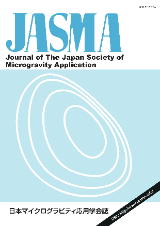All issues

Volume 10 (1993)
- Issue 4 Pages 211-
- Issue 3 Pages 157-
- Issue 2 Pages 93-
- Issue 1 Pages 1-
Volume 10, Issue 2
Displaying 1-6 of 6 articles from this issue
- |<
- <
- 1
- >
- >|
-
J. NISHIMURA1993Volume 10Issue 2 Pages 93-
Published: April 30, 1993
Released on J-STAGE: January 21, 2021
JOURNAL OPEN ACCESSDownload PDF (221K) -
Yoshiyuki ABE, Akira IWASAKI1993Volume 10Issue 2 Pages 94-
Published: April 30, 1993
Released on J-STAGE: January 21, 2021
JOURNAL OPEN ACCESSAs the first experiment of BDH (Bubble Dynamics and Handing) module in TR-IA sounding rocket, a pool boiling experiment with a transparent glass heater and an interferometer was conducted under a relatively low heat flux. During six minutes of microgravity condition, boiling phenomena observation and interferometric observation were schemed in addition to the acquisition of heat transfer data. The heat transfer characteristics showed a large influence due to liquid subcooling, and the interferometric observation implied the existence of stationary microlayer under isolated bubbles.View full abstractDownload PDF (1764K) -
Masaaki OGIHARA, Tsumoru FUJII, Sukeharu ENDO, Michio AOYAMA, Toru ODA1993Volume 10Issue 2 Pages 100-
Published: April 30, 1993
Released on J-STAGE: January 21, 2021
JOURNAL OPEN ACCESSElectrostatic levitation apparatus consisting of a two-dimensional quadrupole and sphere electrode couple was developed for space material experiments. Levitation force arises from a combination of alternating current voltage and direct current applied to two dimensional quadrupole and a sphere electrode couple. Static and stable levitation of a solid sample was achieved using this combination. Sample heating was required in space material experiments. However, temperature could not be raised to the melting point of a sample such as metal and ceramics, since heating rays were mostly shielded by the electrodes. We thus proposed a new concept for levitation electrodes satisfying both static levitation and high temperature heating at the same time. The principal idea is to reduce the occupied area of the electrodes and reuse reflected rays from the levitated sample. This involves the use of a rod electrode of small diameter and reflection mirror. A combination of these constituents should show more different features not only in potential and electric field distribution, but also in heating power compared to prototype levitation apparatus. To confirm this, the following were theoretically analyzed using a computer; potential distribution, sample motion and sample heating power. The electrostatic levitation apparatus with rod electrodes and reflection mirror satisfied both static levitation and high temperature heating of a sample.View full abstractDownload PDF (2126K) -
A. WATANABE, Y. SHIMA, Y. MIYATA, T. SUZUKI1993Volume 10Issue 2 Pages 111-
Published: April 30, 1993
Released on J-STAGE: January 21, 2021
JOURNAL OPEN ACCESSMarangoni convection in the cylindrical container is studied in the drop shaft facility. After the initial deformation of the liquid surface after drop, the center of the surface is heated and the Marangoni convection is driven by the dependency of surface tension on temperature.View full abstractDownload PDF (6017K) -
Katsumi TAKAHASHI, Satoshi ADACHI, Yuji IKEGAMI, Kazuyo SAWASAKl, Jun- ...1993Volume 10Issue 2 Pages 128-
Published: April 30, 1993
Released on J-STAGE: January 21, 2021
JOURNAL OPEN ACCESSThe first mission of the space flyer unit (SFU) is to take place in February of 1995. The SFU is being cooperatively developed by the Ministry of International Trade and Industry (MITI), the Ministry of Education and the Science and Technology Agency.View full abstractDownload PDF (2103K) -
Robert CITRON1993Volume 10Issue 2 Pages 136-
Published: April 30, 1993
Released on J-STAGE: January 21, 2021
JOURNAL OPEN ACCESSThe maiden flight of SPACEHAB's Space Research Laboratory contains a wide range of experiments that cover some very exciting microgravity research activities in the biological and material sciences and in the development and testing of new space systems components. Some of these experiments may lead to new industiral and consumer products of new production methods that may increase the efficiency and productivity of specific American industries. Others might lead to the develop or new drug therapies for certain types of diseases.View full abstractDownload PDF (2406K)
- |<
- <
- 1
- >
- >|